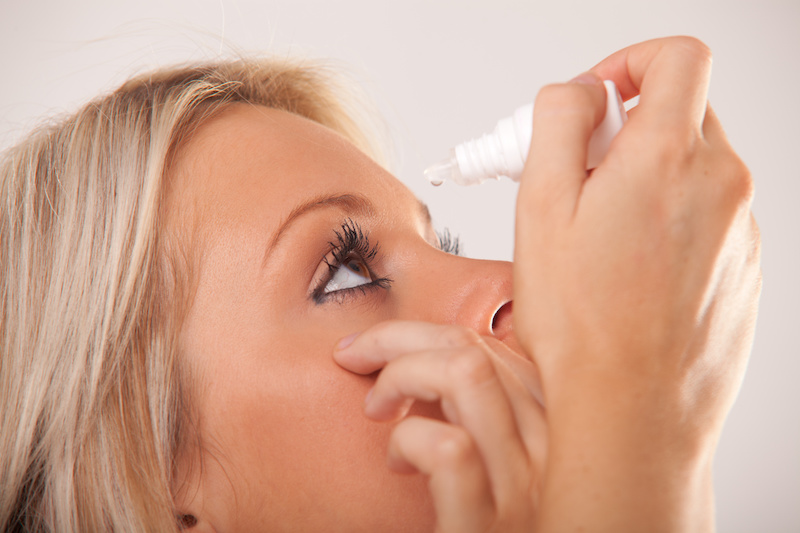Dry eye syndrome (DES or “dry eye”), sometimes referred to as keratitis sicca, is the chronic lack of sufficient tear production to support a health eye. Its consequences range from minor irritations, to the inability to wear contact lenses and an increased risk of corneal inflammation and eye infections.
Signs and symptoms of DES
Persistent dryness, scratchiness and a burning sensation on your eyes are common symptoms of dry eye syndrome. These symptoms alone may be enough for your eye doctor to diagnose dry eye syndrome. Sometimes, he or she may want to measure the amount of tears in your eyes. A thin strip of filter paper placed at the edge of the eye, called a Schirmer test, is one way of measuring this.
Some people with dry eyes also experience a “foreign body sensation” – the feeling that something is in the eye. And it may seem odd, but sometimes dry eye syndrome can cause watery eyes, because the excessive dryness works to overstimulate production of the watery component of your eye’s tears.
What causes DES?
In dry eye syndrome, the tear glands that moisturize the eye don’t produce enough tears, or the tears have a chemical composition that causes them to evaporate too quickly.
Dry eye syndrome has several causes. It can occur:
- as a part of the natural aging process, especially among women over age 40, due to waning testosterone levels.
- as a result of undiagnosed or untreated chronic lid disease (blepharitis).
- as a side effect of many medications, such as antihistamines, antidepressants, certain blood pressure medicines, and birth control pills.
- due to a dry, dusty or windy climate.
- if your home or office has air conditioning or a dry heating system is used excessively.
- if you read or are on the computer all day, due to infrequent blinking.
- as a consequence of certain systemic diseases such as lupus, rheumatoid arthritis, rosacea, hyperthyroidism, and Sjogren’s syndrome.
- long-term contact lens wear, incomplete closure of the eyelids, and chronic eyelid disease.
Dry eye syndrome is more common in women, possibly due to hormone fluctuations. Recent research suggests that smoking, too, can increase your risk of dry eye syndrome. Dry eye has also been associated with incomplete lid closure following blepharoplasty – a popular cosmetic surgery to eliminate droopy eyelids.
Treatment for DES
Dry eye syndrome is a chronic condition that is generally no curable, per se. But the symptoms of dry eye such as dryness, scratchiness, burning, blurring, and light sensitivity can usually be successfully managed.
We may recommend artificial tears, gels, or ointments depending on the diagnosis to alleviate the dry, scratching feeling and foreign body sensation of dry eye. There is an abundance of available over-the-counter for the treatment of DES. After examination, we are able to prescribe effective products for your particular condition. Prescription eye drops for dry eye, such as Restasis, go one step further: they help increase your tear production through a reduction in inflammation, a primary cause of DES.
To reduce the effects of sun, wind and dust on dry eyes, wear sunglasses when outdoors. Wraparound styles offered in our office such as Maui Jim provide the best protection. Indoor humidifiers are very helpful in adding moisture to low-moisture times of the year such as Santa Ana winds.
For more significant cases of dry eye, we may recommend punctal plugs. These tiny devices are inserted in ducts in your lids to reduce the drainage of tears away from your eyes, thereby keeping your eyes more moist. There are other more advanced treatments for the intractable dry eye.
We often recommend a specific nutritional supplements, such as BioTears™ by BioSyntrx (available in our office) which contain Omega 3 and a host of other essential nutrients which reduce inflammation and aid in tear retention. Drinking more water may also relieve symptoms.
If medications are the cause of dry eyes, discontinuing the drug generally resolves the problem. But in this case, the benefits of the drug must be weighed against the side effect of dry eyes. Sometimes switching to a different type of medication alleviates the dry eye symptoms while keeping the needed treatment. Never switch or discontinue your medications without consulting with your doctor first.
Treating any underlying eyelid disease, such as blepharitis, is vital. This may call for antibiotic or steroid eyedrops, plus specific eyelid hygeine (refer to our article on Eyelid Care). For treatment to be successful, accurate diagnosis is critical. Treatment plans are very different depending on the cause found. There are a host of dry eye support products that may be found at: www.dryeyezone.com.
If you have symptoms of DES, schedule a visit with us for a comprehensive dry eye examination.
Dan B. Carver, O.D., F.A.A.O.

